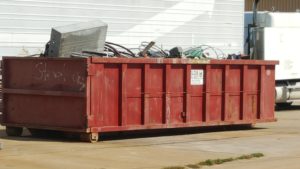The Generator Improvements Rule created ~60 changes to the Federal regulations of the USEPA for the management of hazardous waste. Some of those changes are significant; such as the allowance for Episodic generation of hazardous waste by a VSQG or SQG. (Read: Episodic Generation of Hazardous Waste for a VSQG or Episodic Generation of Hazardous Waste for an SQG). Some were minor but critical; such as creating a definition for a commonly used term like the Central Accumulation Area at 40 CFR 260.10. And others are just typographical, like this one.
40 CFR 261.6(c)(6) used to read:
“Scrap metal” is bits and pieces of metal parts (e.g.,) bars, turnings, rods, sheets, wire) or metal pieces that may be combined together with bolts or soldering (e.g., radiators, scrap automobiles, railroad box cars), which when worn or superfluous can be recycled.
Now it reads:
“Scrap metal” is bits and pieces of metal parts (e.g., bars, turnings, rods, sheets, wire) or metal pieces that may be combined together with bolts or soldering (e.g., radiators, scrap automobiles, railroad box cars), which when worn or superfluous can be recycled.
|
Contact me with any questions you may have about the generation, identification, management, and disposal of hazardous waste Daniels Training Services, Inc. 815.821.1550 |
What’s the diff?
It’s the superfluous end parenthesis “)” after the first “e.g.,” It used to look like this: (e.g.,) and now looks like this: (e.g.,
Just a minor typographical error. It doesn’t impact the definition of scrap metal at all. But for those of us interested in the details of the regulations it is a relief to see even these minor corrections.
The Generator Improvements Rule contains a lot more changes. Some of them are significant enough to affect your day-to-day compliance status when managing hazardous waste. Make certain you have satisfied yourself of the following:
- Identify the status of the Generator Improvements Rule in your state.
- Determine what changes you will need to comply with the rule’s more stringent requirements.
- Consider if some of the rule’s less stringent requirements will ease your regulatory compliance burden.
- Contact Daniels Training Services if you have any questions about the management of hazardous waste.

